
USS Indianapolis (CL/CA-35) was a Portland-class heavy cruiser of the United States Navy, named for the city of Indianapolis, Indiana. Launched in 1931, it was the flagship for the commander of Scouting Force 1 for eight years, then flagship for Admiral Raymond Spruance from 1943 to 1945 while he commanded the Fifth Fleet in battles across the Central Pacific during World War II.

Chester William Nimitz was a fleet admiral in the United States Navy. He played a major role in the naval history of World War II as Commander in Chief, US Pacific Fleet, and Commander in Chief, Pacific Ocean Areas, commanding Allied air, land, and sea forces during World War II.

David Glasgow Farragut was a flag officer of the United States Navy during the American Civil War. He was the first rear admiral, vice admiral, and admiral in the United States Navy. He is remembered for his order at the Battle of Mobile Bay, usually paraphrased as "Damn the torpedoes, full speed ahead" in U.S. Navy tradition.
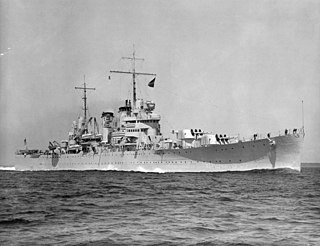
USS Boise (CL-47) was a light cruiser of the Brooklyn class in the United States Navy. The cruiser was named for Boise, the capital city of the state of Idaho. Commissioned in 1938, she saw extensive service during World War II, taking part in fighting in the Mediterranean and Pacific theaters. Following the war the ship was decommissioned in 1946 and lay idle until sold to Argentina in 1951. Renamed ARA Nueve de Julio, the ship remained in service with the Argentinian Navy until 1978, after which she was taken to Brownsville, Texas and scrapped in 1983.
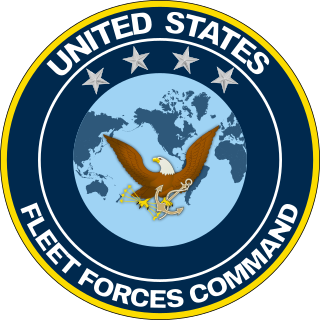
The United States Fleet Forces Command (USFF) is a service component command of the United States Navy that provides naval forces to a wide variety of U.S. forces. The naval resources may be allocated to Combatant Commanders such as United States Northern Command (USNORTHCOM) under the authority of the Secretary of Defense. Originally formed as United States Atlantic Fleet (USLANTFLT) in 1906, it has been an integral part of the defense of the United States of America since the early 20th century. In 2002, the Fleet comprised over 118,000 Navy and Marine Corps personnel serving on 186 ships and in 1,300 aircraft, with an area of responsibility ranging over most of the Atlantic Ocean from the North Pole to the South Pole, the Caribbean Sea, Gulf of Mexico, and the waters of the Pacific Ocean along the coasts of Central and South America.

USS Liscome Bay (ACV/CVE-56) was the second of fifty Casablanca-class escort carriers built to serve the United States Navy during World War II. Launched in April 1943 and commissioned the following August, she was named for Liscome Bay in Dall Island in the Alexander Archipelago of Alaska. On 24 November 1943, her munitions were catastrophically detonated by a torpedo attack by the Japanese submarine I-175 while she was acting as the flagship of Carrier Division 24, which was supporting operations on Makin. She quickly sank with the loss of 644 officers and sailors. Her loss is the deadliest sinking of a carrier in the history of the United States Navy.

Ernest Joseph King was a fleet admiral in the United States Navy who served as Commander in Chief, United States Fleet (COMINCH) and Chief of Naval Operations (CNO) during World War II. He directed the United States Navy's operations, planning, and administration and was a member of the Joint Chiefs of Staff and was the U.S. Navy's second-most senior officer in World War II after Fleet Admiral William D. Leahy, who served as Chairman of the Joint Chiefs of Staff.
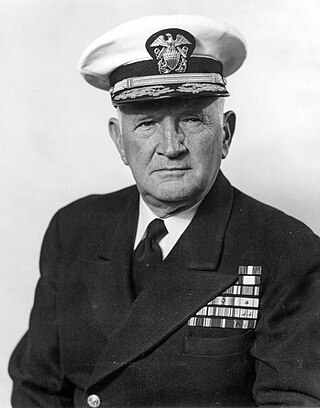
Jesse Barrett "Oley" Oldendorf was an admiral in the United States Navy, famous for defeating a Japanese force in the Battle of Leyte Gulf during World War II. He also served as commander of the American naval forces during the early phase of the Battle of the Caribbean. In early 1942, a secret group of senior Navy officers empaneled by President Franklin D. Roosevelt assessed him as one of the 40 most competent of the 120 flag officers in the Navy.

Edward Walter Eberle was an admiral in the United States Navy, who served as Superintendent of the United States Naval Academy and the third Chief of Naval Operations.

Norman (Nicholas) Scott was a rear admiral in the United States Navy. He was killed along with many of his staff when the ship he was on – the light cruiser USS Atlanta – was hit by gunfire from the heavy cruiser USS San Francisco during the nighttime fighting in the Naval Battle of Guadalcanal. He was the second of five US Navy admirals killed in battle during WWII, including: Isaac C. Kidd ; Daniel J. Callaghan ; Henry M. Mullinnix ; and Theodore E. Chandler.
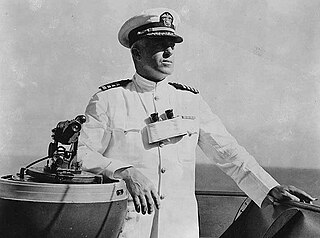
Daniel Judson Callaghan was a United States Navy officer who received the Medal of Honor posthumously for his actions during the Naval Battle of Guadalcanal. In a three-decades-long career, he served his country in two wars. Callaghan served on several ships during his first 20 years of service, including escort duties during World War I, and also filled some shore-based administrative roles. He later came to the attention of President Franklin D. Roosevelt, who appointed Callaghan as his naval aide in 1938. A few years later, he returned to command duties during the early stages of World War II. An enemy shell killed Callaghan on the bridge of his flagship, USS San Francisco, during a surface action against a larger Japanese force off Savo Island. He was the third of five US Navy admirals killed in battle during WWII, including: Isaac C. Kidd ; Norman Scott ; Henry M. Mullinnix ; and Theodore E. Chandler.

Admiral Joseph James "Jocko" Clark, USN was an admiral in the United States Navy, who commanded aircraft carriers during World War II. Born and raised in Indian Territory and a member of the Cherokee Nation, in 1917 he became the first Native American to graduate from the United States Naval Academy. Clark preferred to be called "J. J." or by the nickname "Jocko" instead of his full name.

Henry Maston Mullinnix was a United States Navy aviator and admiral who served in World War I and World War II. Mullinnix was killed in action while commanding a Navy escort carrier division and task force group when his flagship, the escort carrier USS Liscome Bay (CVE-56), was sunk by a Japanese submarine near the Gilbert Islands during World War II. He was the fourth of five US Navy admirals killed in battle during WWII, including: Isaac C. Kidd ; Norman Scott and Daniel J. Callaghan ; and Theodore E. Chandler.

The timeline of events of the Spanish–American War covers major events leading up to, during, and concluding the Spanish–American War, a ten-week conflict in 1898 between Spain and the United States of America.

Harry Handly Caldwell was America's first submarine captain. He became the first naval submarine commanding officer, of any nation, when he assumed command of USS Holland (SS-1) on October 12, 1900.

Naval Station Pearl Harbor is a United States naval base on the island of Oahu, Hawaii. In 2010, as part of the recommendations of the Base Realignment and Closure (BRAC) commission, the naval station was consolidated with the United States Air Force's Hickam Air Force Base to form Joint Base Pearl Harbor–Hickam. Since 1940, Pearl Harbor has been the headquarters of the United States Pacific Fleet.
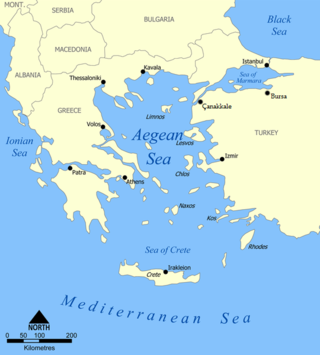
Exercise Longstep was a ten-day NATO naval exercise held in the Mediterranean Sea during November 1952 under the overall command of Admiral Robert B. Carney, USN, the Commander-in-Chief Allied Forces Southern Europe (CINCAFSOUTH). This exercise involved over 170 warships and 700 aircraft, and it featured a large-scale amphibious assault along the western coast of Turkey. With Exercise Grand Slam, this exercise served as the prototype for future NATO maritime exercises in the Mediterranean Sea during the Cold War.
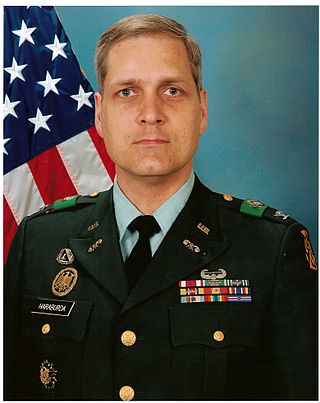
Scott Stanley Haraburda is an American soldier, engineer, inventor, and 2nd dan judoka. In addition to making key contributions to the development of heat exchangers and spacecraft propulsion, he led a team of military officers in 2007 to Kuwait to correct many of the contingency contracting problems identified by the Gansler Commission. He is known nationally as the president of the Indiana Society of Professional Engineers who led the opposition to a state governmental panel recommendation in 2015 to eliminate licensing of engineers in Indiana.

Samuel Rhoads Franklin was a rear admiral in the United States Navy. He participated in the important Battle of Hampton Roads off the U.S. state of Virginia in 1862, served as the superintendent of the U.S. Naval Observatory in Washington, D.C., from 1884 to 1885, and was president of the International Marine Conference of 1889.
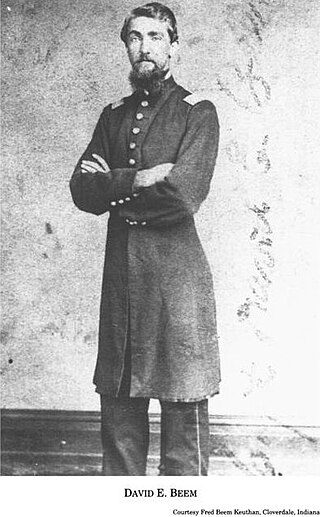
David Enoch Beem was a prominent lawyer, banker, and American Civil War veteran from Spencer, Owen County, Indiana. Beem, who attained the rank of captain of Company H, 14th Indiana Infantry Regiment, fought in numerous battles in the eastern United States before he mustered out of the Union army in June 1864. After the war Beem resumed his law practice in Spencer and became involved in local banking ventures. He was also active the state's Republican Party and civic affairs. Beem, a graduate of Indiana University, class of 1860, served on Purdue University's board of trustees for eighteen years. He also participated in the Grand Army of the Republic at local and state levels. Beem's papers and letters are preserved in the collections of the Indiana Historical Society in Indianapolis. The David Enoch Beem House, his former residence in Spencer, is listed on the National Register of Historic Places.























